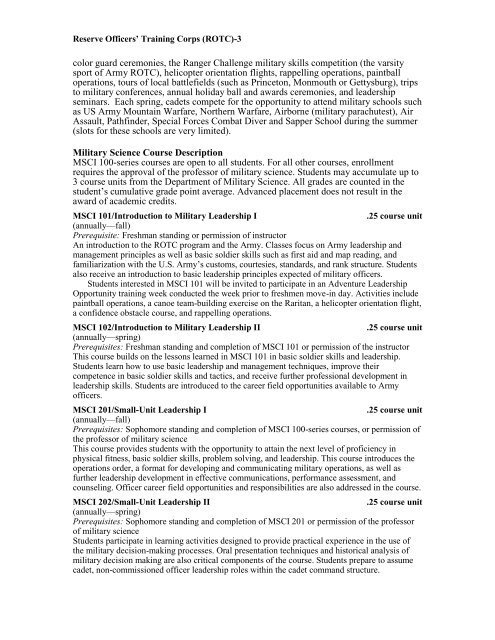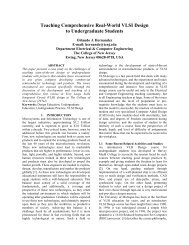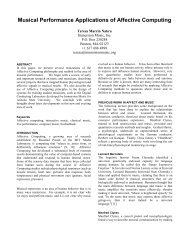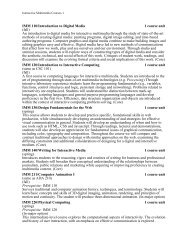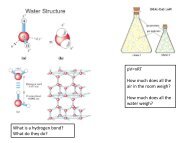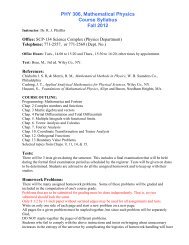Reserve Officers' Training Corps (ROTC)
Reserve Officers' Training Corps (ROTC)
Reserve Officers' Training Corps (ROTC)
You also want an ePaper? Increase the reach of your titles
YUMPU automatically turns print PDFs into web optimized ePapers that Google loves.
<strong>Reserve</strong> Officers’ <strong>Training</strong> <strong>Corps</strong> (<strong>ROTC</strong>)-3<br />
color guard ceremonies, the Ranger Challenge military skills competition (the varsity<br />
sport of Army <strong>ROTC</strong>), helicopter orientation flights, rappelling operations, paintball<br />
operations, tours of local battlefields (such as Princeton, Monmouth or Gettysburg), trips<br />
to military conferences, annual holiday ball and awards ceremonies, and leadership<br />
seminars. Each spring, cadets compete for the opportunity to attend military schools such<br />
as US Army Mountain Warfare, Northern Warfare, Airborne (military parachutest), Air<br />
Assault, Pathfinder, Special Forces Combat Diver and Sapper School during the summer<br />
(slots for these schools are very limited).<br />
Military Science Course Description<br />
MSCI 100-series courses are open to all students. For all other courses, enrollment<br />
requires the approval of the professor of military science. Students may accumulate up to<br />
3 course units from the Department of Military Science. All grades are counted in the<br />
student’s cumulative grade point average. Advanced placement does not result in the<br />
award of academic credits.<br />
MSCI 101/Introduction to Military Leadership I<br />
.25 course unit<br />
(annually—fall)<br />
Prerequisite: Freshman standing or permission of instructor<br />
An introduction to the <strong>ROTC</strong> program and the Army. Classes focus on Army leadership and<br />
management principles as well as basic soldier skills such as first aid and map reading, and<br />
familiarization with the U.S. Army’s customs, courtesies, standards, and rank structure. Students<br />
also receive an introduction to basic leadership principles expected of military officers.<br />
Students interested in MSCI 101 will be invited to participate in an Adventure Leadership<br />
Opportunity training week conducted the week prior to freshmen move-in day. Activities include<br />
paintball operations, a canoe team-building exercise on the Raritan, a helicopter orientation flight,<br />
a confidence obstacle course, and rappelling operations.<br />
MSCI 102/Introduction to Military Leadership II<br />
.25 course unit<br />
(annually—spring)<br />
Prerequisites: Freshman standing and completion of MSCI 101 or permission of the instructor<br />
This course builds on the lessons learned in MSCI 101 in basic soldier skills and leadership.<br />
Students learn how to use basic leadership and management techniques, improve their<br />
competence in basic soldier skills and tactics, and receive further professional development in<br />
leadership skills. Students are introduced to the career field opportunities available to Army<br />
officers.<br />
MSCI 201/Small-Unit Leadership I<br />
.25 course unit<br />
(annually—fall)<br />
Prerequisites: Sophomore standing and completion of MSCI 100-series courses, or permission of<br />
the professor of military science<br />
This course provides students with the opportunity to attain the next level of proficiency in<br />
physical fitness, basic soldier skills, problem solving, and leadership. This course introduces the<br />
operations order, a format for developing and communicating military operations, as well as<br />
further leadership development in effective communications, performance assessment, and<br />
counseling. Officer career field opportunities and responsibilities are also addressed in the course.<br />
MSCI 202/Small-Unit Leadership II<br />
.25 course unit<br />
(annually—spring)<br />
Prerequisites: Sophomore standing and completion of MSCI 201 or permission of the professor<br />
of military science<br />
Students participate in learning activities designed to provide practical experience in the use of<br />
the military decision-making processes. Oral presentation techniques and historical analysis of<br />
military decision making are also critical components of the course. Students prepare to assume<br />
cadet, non-commissioned officer leadership roles within the cadet command structure.


